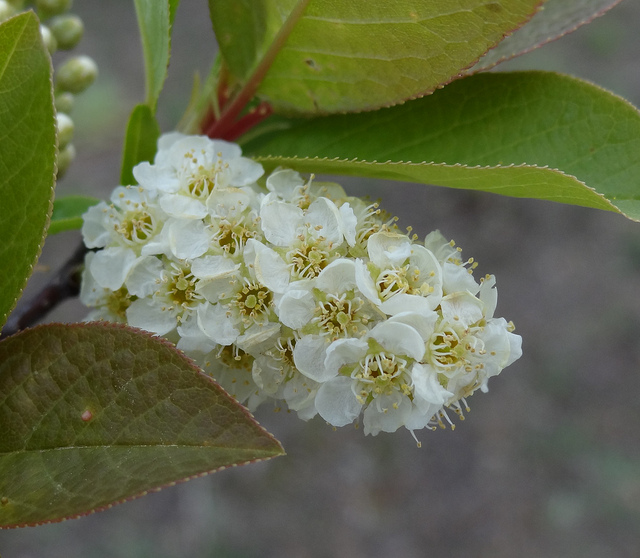Chokecherry
Prunus virginiana L.
Description
Chokecherry, also called Virginia bird cherry ², is a member of the rose family (Rosaceae) and forms a shrub or small tree up to 30 feet tall ¹. The bark is smooth and gray ¹ and has horizontal lines of lenticels 5. Its alternate leaves are from 1.5 to 5 inches long with saw-toothed edges. Crushed leaves produce a strong bitter scent ¹. Flowers are produced in clusters after leafing out and are white 5-petaled, and 1/4 to 3/8 inch across 2,5. The pea-sized ² fruit is red or burgundy, turning black and wrinkly when mature ¹ .

Leaves and flowers of chokecherry. C. Raimond, Maryland Biodiversity Project ³

Fruit of chokecherry. @ M. Tillett* 2012 Maryland Biodiversity Project ³
Distribution
Chokecherry is widely distributed across the northern USA and southern Canada. It is found in all but eight states or territories of the US 6. Chokecherry is naturally found in the mountainous regions of Western Maryland and can be found elsewhere escaped from cultivation ³.

Natural range of Chokecherry. Wikimedia Commons 4
Wildlife Importance
Chokecherry is a larval host for the Eastern Swallowtail and Coral Hairstreak butterflies³. It is also host to several moth species ³. Wildlife including birds, rabbits, chipmunks, mice, and bears consume its fruit 1,5.
Economic Importance
Indian tribes of North America dried or boiled the fruit to remove the bitter tase and detoxify them 6. The fruit was eaten whole or made into a tea or used as a flavoring to other foods 6. Mature fruits are used today for making jams, jellies, pie fillings and sauces 5. Choke cherry is used for erosion control due to its extensive root system 5. It is also used for horticulture and fruit production 5. The fleshy fruit may be used to produce
Threats
Chokecherry is susceptible to numerous pests and diseases. Potential diseases include black knot, leaf curl, root rot and fireblight ². Pests include tent caterpillars and Japanese beetles ².
Interesting Facts
- In 1629 chokecherry was imported from North America to England where it is widely cultivated 5.
- Seeds, leaves and stems are highly toxic as they produce hydrocyanic acid (HCN) and can cause illness or death 5. Toxicity is exhibited when consumption exceeds 0.25% of the body weight. Consumption of 4 ounces of young leaves can be toxic to a 100 pound animal 6.
- The Cherokee used a tea made from chokecherry to give to women when labor pains started 6.
References
- North Carolina State Extension: Prunus virginica
- Missouri Botanical Garden: Prunus virginiana
- Maryland Biodiversity Project: Chokecherry
- Wikimedia Commons: Prunus virginiana
- USDA-NRCS Fact Sheet: Chokecherry
- USDA-NRCS Plant Guide: Chokecherry
* Imaged used with permission of photographer.
Contributed by J. Hull
Towson University Glen Arboretum
